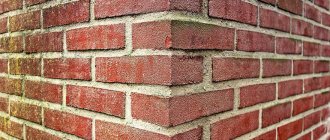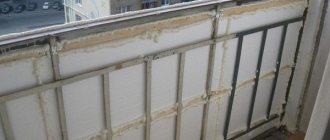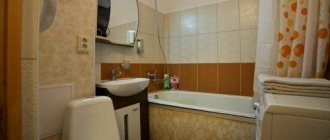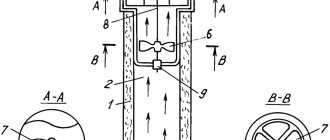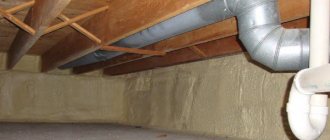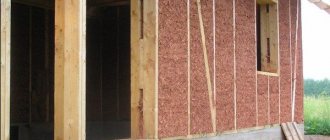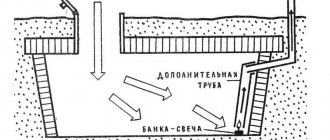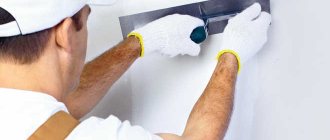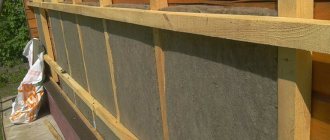Waterproofing of apartments, offices, warehouses
Freezing of walls: causes and methods of elimination
Reasons for freezing of walls and corners
Freezing of walls and corners is a very unpleasant phenomenon, which is familiar to many owners of corner apartments, as well as apartments on the windward side of the house and near the elevator shaft.
First frosty day:
Second frosty day (even more ice):
The main reason for freezing is the formation of “cold bridges” in the structure.
“Cold bridges” form in areas where the thermal insulation capacity of walls is reduced. This may be due to their insufficient thickness, due to the opening of interpanel seams, the formation of cracks or the walls getting wet.
The lack of wall thickness is manifested by continuous freezing of the walls (over the entire area) and is compensated by lining the walls with insulation or applying other heat-insulating coatings. However, most often apartment owners encounter local (focal) freezing of walls in the corners, as shown in the photo above.
Eliminate freezing of walls and corners
If you have access to a freezing corner (interpanel seam) from the outside and inside of the room, it is advisable to carry out heat and waterproofing work both outside and inside the room. The list of heat and waterproofing works from inside the apartment is given below.
When repairing freezing walls and corners at interpanel seams, it is recommended:
- open such seams;
- hermetically fill the existing voids with heat-insulating waterproofing material Dehydrol Lux grade 4 “Plastering and repair thermal waterproofing with penetrating effect” (consumption 0.95 kg per 1 dm 3 of the cavity being filled);
- in case of severe freezing, apply to areas of the walls where freezing was observed a layer of 5-15 mm (depending on the intensity of freezing) of Dehydrol Lux material grade 4 “Plastering and repair thermal waterproofing with penetrating effect” (consumption 4.45 kg per 1 m 2 for a layer material 5 mm).
remove wet and destroyed thermal insulation from them to an accessible depth, clean the opened seam from debris and dirt;
If necessary, additionally perform concrete repairs and final protection and waterproofing using:
- Dehydrol lux brand 5 “Repair and penetrating waterproofing” - for sealing chips, potholes, cracks and joints (consumption 1.7 kg per 1 dm 3 or 0.8 kg per 1 linear meter of fines with a cross section of 20x20 mm);
- Dehydrol lux brand 3 “Penetrating waterproofing and cementation of voids” - for eliminating surface porosity (up to gloss) and finishing waterproofing of monolithic concrete sections of walls, ceilings or floors, especially in areas where moisture was observed inside the concrete (consumption 1 kg per 1 m 2 );
- Conticide brand 3 “Impregnation concentrate and additive for increasing corrosion resistance with the effect of combating dampness” - to combat dampness of walls, ceilings and floors in rooms with high humidity (consumption 0.1 l per 1 m 2).
As a rule, these simple measures taken from inside the room are sufficient to eliminate freezing of walls and corners:
Remember! Thermal insulation without protection from moisture and getting wet quickly loses its protective properties.
Accordingly, the use of a final protective layer made of an effective waterproofing material (such as, for example, Dehydrol) is the key to successful thermal insulation and prevention of freezing of walls and corners in rooms.
Reasons for freezing corners and walls
Frost on the walls of the room most often forms in apartments located on the corner of the house or facing the wind. In addition, this problem is often encountered in situations where the outer wall of the room is adjacent to an elevator shaft or to buildings that are not provided with sufficient temperatures for heating.
Regardless of the location of your home, the main reason is insufficient sealing of the joints between the walls, which is why icing is usually observed in the corners of the room. If the thickness of the waterproofing material is insufficient, over time you will encounter an increase in humidity inside the walls, and as a result, freezing.
What are the reasons for the deterioration of waterproofing in a house? Most often, freezing of walls is associated with a violation of the structure of the house. In panel buildings, such a violation may be insufficient thickness of floors and partitions, subsidence of the building foundation, as a result of which cracks appear on the walls. In addition, if there is high humidity at a low temperature in the apartment and outside at the same time, then the wall of such a room will quickly absorb water, which in the future will be converted into frost.
Another common prerequisite for freezing is improper insulation of the walls inside the apartment. If the thickness of the thermal insulation materials is insufficient, and the work was carried out without complying with technical standards, then you will soon encounter high humidity in the walls, the appearance of fungus and mold. Such defects are fraught not only with damage to cosmetic repairs and freezing of the house, but also with undermined health of the homeowner, which is why they require urgent elimination.
Other reasons include:
- depressurization of interpanel seams;
- insufficient heating of the house in winter;
- violations in the sealing of windows, doorways, balconies and loggias;
- constant drafts;
- regular increase in humidity by apartment owners (excessive wet cleaning, washing, flooding of the room, a large number of indoor flowers that require frequent watering);
- poor exhaust and ventilation system.
How to eliminate the inconvenience
Before embarking on comprehensive prevention of consequences, you should find the place of freezing and determine the causes. To do this, carefully examine the wall and try to determine what caused the frost to appear.
When the cause has been discovered, the elimination of the resulting defects should begin. For this procedure you will need a wall leveling compound, a spatula, a brush, coarse sandpaper and an acrylic primer.
Grouting should be done as follows:
- remove wallpaper, tiles or paint from the wall;
- treat all existing cracks and breaks with putty or other mixture to level the walls;
- after drying, level the wall with sandpaper;
- apply primer.
It is recommended to repeat the entire process several times, increasing the thickness of the grout layer. You should not use polyurethane foam to fill cracks, since it absorbs moisture well from the street, allowing excess water to enter the room.
However, the method described above is only eliminating the consequences, but not the causes of freezing. To get rid of the root of the problem forever, you will need high-quality external wall insulation.
Insulation of problem areas
It is better to insulate walls from the outside, since internal insulation has a number of disadvantages. Firstly, thermal insulation from the inside, due to the thickness of the materials used, can greatly reduce the size of the usable area, which is especially important for residents of panel houses. Secondly, failure to comply with insulation technology is fraught with even worse humidity in the apartment. And thirdly, with the help of internal thermal insulation you still cannot avoid the need to change the ventilation and heating systems.
However, internal insulation also has a number of advantages. First of all, you will not have to obtain permission to change the facade from the management company. In addition, you can insulate the apartment from the inside on your own.
Panel buildings can be insulated using warm plaster or liquid materials. However, these modern materials have not yet been sufficiently studied. Moreover, such remedies will not solve the problem of loose interpanel seams and cracks.
It is recommended to insulate the house from the facade. If you live above the first floor, you will have to contact a construction company, which will take over the entire process.
Due to insulation, the thickness of the walls will increase, which will increase the temperature in the living room. In addition, by capturing 30–40 cm of the neighbor’s wall, you will completely solve the problem of ventilated interpanel joints.
Non-standard solutions
In addition to insulation, you can change the design of the corners in the room. Corners that are rounded or smoothed with plaster will freeze less. Also, builders recommend installing plasterboard structures in the corners of apartments with lighting fixtures mounted in them. As a result of the thermal effect from the light bulb, the temperature inside the structure will increase and the humidity will decrease. You can make pilasters outside the building in private houses. In wooden buildings, you can line the joints between logs with thermal insulation material.
To completely eliminate wall freezing, a whole range of measures are required, which should be taken immediately after the first signs of a problem appear.
How to properly insulate walls?
To ensure the most optimal microclimate in the house and avoid the negative consequences of freezing and getting wet walls, you need to properly insulate the walls.
If it is technically impossible to do this from the outside, then you can insulate the walls from the inside, the main thing is to approach this issue competently. Regardless of the location and extent of the problem of wall freezing, the entire surface must be insulated. Carrying out such insulation from the outside is often difficult due to the design features of the building, the climate where the house is located and other reasons. Therefore, in such a situation, it will be possible to really insulate the house only from the inside.
To do this, you need to carefully process the wall and fill the plaster onto a special fabric mesh, which will provide strong adhesion and excellent thermal insulation.
Possible reasons why the walls in the apartment are frozen
A wall in an apartment freezes most often due to the fact that a large amount of moisture accumulates in it. As a result, its surface becomes damp or wet. The reasons for this problem may be hidden in the following:
- Poor organization of the ventilation system. Because of this, the natural drying of the walls is significantly worsened. Liquid constantly accumulates in them, regardless of the factors why this happens.
- Insufficient heating during the cold heating season of the year. In this case, the premises in the houses do not warm up properly. Thus, the wall in the apartment freezes in a very short period of time.
- Low competence of the builders carrying out the construction of the building. Often, specialists, due to their laziness or lack of experience, poorly seal cracks directly next to window frames or between structural elements.
- Waterproofing that has become unusable. This problem most often occurs on the upper floors of multi-story buildings. If a wall in an apartment freezes, the owner must understand where to turn. Most often, the management company or housing office is responsible for waterproofing a house on the upper floors.
- The appearance of cracks in the house. This reason is considered by experts to be the most difficult to correct. This is due to the fact that in such situations the house needs to undergo major repairs. If work is not carried out to eliminate cracks, they will increase in size every year. This applies to both length and width.
Thus, the walls in the apartment freeze due to a large number of different reasons. That is why, in order to get rid of such a problem, you first need to determine the factors that influenced its occurrence.
What to do if the wall is frozen
You can understand this situation and take effective measures only after finding out the reason for the freezing of the wall. To do this, you need to contact the company responsible for maintaining your home. This could be a management company or a homeowners association.
A written application will need to be submitted . It will be reviewed within the framework of current legislation, after which a specialist will be sent to you to inspect the condition of the wall.
After the procedure, the owner will be given a corresponding certificate. This document is confirmation of an inspection to identify the cause of freezing.
You can immediately contact a company specializing in thermal imaging surveys . This is a paid type of service that allows you to get complete information about the problem.
A written opinion from a specialist from this company will allow you to contact directly the management of the management company or HOA and more quickly resolve the issue of correcting the deficiency.
The walls in the apartment freeze: what to do in each specific case
If a wall freezes in your own apartment, a person needs to perform a number of specific actions that directly depend on the cause of the problem. They are as follows:
- If the room has poor ventilation, it is necessary to reconstruct it or install a new system. The longer you wait to solve this problem, the more serious its consequences will be for the apartment and for the house as a whole.
- If a wall in an apartment is frozen due to the heating system, there are three possible options to correct this situation. The owner of the property can submit an application to the housing office that provides him with the relevant services. If you use autonomous heating, you need to either change the heating devices or change the process of using them.
- If there are a large number of cracks in the structure of the building, it is necessary to use special sealants that allow them to be closed. In addition, it is additionally necessary to plaster the outside of the structures with a special material that will prevent precipitation from getting into the cracks of the house material. What to do if the wall in the apartment freezes even after such actions should be decided by a qualified craftsman with relevant experience.
- Sometimes you can notice that a wall in an apartment is frozen not because of problems with heating devices or ventilation, but due to poor waterproofing of the structure. In such a situation, it is enough just to replace the materials that prevent precipitation from penetrating into the room.
- If cracks begin to appear in the house, you first need to assess the possibility of their impact on the integrity of the entire building. In some cases, this problem can be eliminated by a major overhaul. Sometimes it is not advisable to carry out any work. That is why there is no need to eliminate freezing of the room.
Thus, there are quite a lot of ways to deal with a frozen wall in an apartment. In each specific case, the solution to the problem must be approached as carefully and carefully as possible. It is important to understand that sometimes eliminating unfavorable indoor conditions can lead to a worsening of the situation.
What to do with a frozen wall in an apartment
If you have a frozen external wall in your apartment, you need to choose from the most accessible ways to solve this problem. Currently, the following popular methods are distinguished by their effectiveness and reliability, which can be used by any premises owner without any problems:
- External insulation of walls that are in direct contact with the environment. For this purpose, foam plastic has recently been most often used, sheets of which are attached to the wall with special elements. The top of this material is plastered and painted. If a wall in an apartment freezes, it is up to the owner of this property to decide what to do. You can use polystyrene foam only after thoroughly drying the surface.
- Internal wall insulation. In most cases, property owners do not carry out such work, since it requires a complete renovation of the room. If the outer wall of an apartment is frozen, most people prefer to protect it from the outside rather than from the inside. In fact, the second option has a lot of advantages, which is why you shouldn’t immediately discard it without consideration.
- Use of heating devices. Most often, electrical devices are used for this, the heat flow of which is directed towards the part of the wall damaged by high humidity. Such measures are only a temporary solution to the problem, which is aimed at preventing further adverse effects. In addition, the use of heating devices allows you to prepare the wall for work related to its insulation or the installation of proper waterproofing. It is prohibited to perform such actions without first drying the surface.
Thus, there are a large number of options for what to do if the wall in the apartment is frozen. All of them are worth considering before choosing one or another way to solve the problem.
The wall in the apartment is freezing: where can I turn?
If a wall in an apartment is frozen, the owner of the premises usually does not know where to turn. In fact, the answer to this question is quite simple - you need to submit a corresponding application either to the management company or to the HOA.
If the cause of the problem lies in the poor quality of the work of the developer, the owner of the premises should contact the developer with a complaint. In such a situation, what to do about a frozen wall in an apartment should be decided by the business entity that was responsible for the construction of the house.
If none of the organizations to which the appeal was made takes any action, it is necessary to address the complaint to such government bodies as:
- prosecutor's office;
- city or district administration;
- Maintenance of housing inspection;
- court.
If a wall in an apartment is frozen, the owner must decide where to go. The law does not prohibit filing several complaints in parallel with each other to various authorities.
Prevention of wall freezing
To prevent the wall from freezing in the future, you must do the following:
- insulate and glaze the balcony if the problem wall is located nearby;
- check and repair, if necessary, the ventilation system;
- patch cracks and defects with silicone sealant.
All these recommendations taken together are the answer to the question of what to do if the wallpaper peels off on a cold wall. This is due to increased dampness that needs to be dealt with.
Application for freezing of walls in an apartment
It is necessary to draw up a statement about freezing of walls in an apartment in the correct way. Otherwise, the complaint may not be considered. First of all, the text of the document should indicate the name of the organization to which it is being submitted. Mandatory elements of the application also include the applicant’s full name, address of residence and contact for feedback.
An application for freezing of walls in an apartment must contain the following attributes:
- The essence of the appeal. It can be laid out in any form. It is necessary to explain the reason for writing the application and the specifics of the problem.
- Evidence base. This is usually the certificate of inspection of the apartment by a specialist.
- A complaint about freezing of walls in an apartment without appropriate evidence of a problem may be rejected.
- Date of registration and signature of the applicant.
- Links to the current legislation of the Russian Federation. It is necessary to indicate the norms that this or that organization has violated.
There is also an option for what to do if a wall in the apartment, located in the corridor or stairwell, freezes. In this case, it is advisable to file a collective complaint from several property owners in the building.
How to independently determine freezing of walls in an apartment
There are several options for determining whether a wall in an apartment is freezing. It must first be carefully inspected, paying attention to changes such as:
- peeling of finishing materials (wallpaper, plaster);
- the appearance of condensation;
- the appearance of frost in the morning and evening;
- severe cooling of the surface;
- abundant growth of fungus and mold.
Methods of how to determine freezing of a wall in an apartment allow anyone to do this. All changes seen must be captured on camera, since in the future, during the proceedings, this may become evidence of the guilt of the organization responsible for ensuring normal living conditions for people.
Before you get rid of freezing of the walls in the apartment yourself, you need to carry out an inspection of the premises by a specialist. In this case, it will be possible to obtain compensation for the money spent in the future.
Drawing up a complaint about freezing of walls in an apartment
Any complaint about freezing of walls in an apartment must be supported by appropriate evidence. It includes:
- certificate of inspection of the premises by a specialist;
- photographs of a wall that was frozen;
- written refusal of the management company to take action to correct the problem, etc.
The more thorough the text of the complaint, the more chances the applicant will have to get help before getting rid of the freezing walls in the apartment.
The consideration of a complaint requires a certain period of time. That is why experts advise handling it immediately after the first signs of freezing appear. In this case, before the onset of severe cold weather, it will be possible to correct the problem with the wall.
Thermal imager and freezing of walls in an apartment
What needs to be done to eliminate leaks and freezing of external walls?
To eliminate leaks on external walls, it is necessary to reseal the seams of the panels with 100 percent opening of the joints on all floors located vertically above the leaking area.
Freezing occurs due to damage to the building envelope and disruption of the building's thermal regime. The reasons for freezing of the outer panels of a multilayer structure can be subsidence of the insulation and disruption of its structure under the influence of temperature and humidity deformations, as well as the use of material for stiffeners that is denser than that provided for in the design, the presence of heat-conducting inclusions (for example, metal embedded parts in houses of some series) .
Single-layer blocks and panels are subject to freezing due to waterlogging (increased initial or operational humidity) or local inclusion of material that is denser than that provided for in the design. Freezing of joints is a consequence of leaks (overmoistening of the sealing material) or insufficient insulation (sealing with heat-conducting materials or sinks and gaps in the sealing).
In some cases, freezing of the walls of the upper floors occurs due to a violation of the thermal insulation of the attic floor or insufficient heating.
To identify the causes of freezing and assess the extent of the damaged structure, it is probed by taking three to four samples along the thickness of a single-layer panel or joint and three samples of insulation for multi-layer panels, after which the defective areas are opened to assess the condition of the panel interfaces.
If the humidity of the freezing area exceeds the permissible level, the structure or joint must be dried, and further penetration of moisture must be prevented (carry out work to seal all defective areas).
We recommend sealing the entire perimeter of the slab, even if freezing occurs at one point.
In all other cases, work to identify the causes of freezing is carried out by specialized organizations.
Leaks along the sealing line of balcony slabs occur due to poor-quality sealing of seams or other defects in the sealing areas of the balcony slab and door frame, as well as insufficient slope of the balcony slab (less than 2%).
When inspecting the junction of the balcony slab with the wall, visible leaks in the connection or defects in the assembly (lack of a threshold, etc.) are identified, and the slope of the balcony slab is also measured.
Based on the results of the inspection of the balcony structures, a decision is made on the method of eliminating the leak (creating a slope along the surface of the balcony floor slab, sealing the area where the slab is embedded in the wall, sealing the interface areas between the balcony slab and door frames, changing the waterproofing, installing overhangs made of galvanized steel, etc. ).
How is a diagnostic examination performed?
Our experts usually carry out a visual and visual-instrumental inspection of the object, in accordance with the requirements of SP 13-102-2003 “Rules for the inspection of load-bearing building structures of buildings and structures.” Another necessary stage is an external inspection of the building facades and joints of external wall panels, inspection of defects in the apartments of a residential building, with selective recording on a digital camera, which meets the requirements of SP 13-102-2003 clause 7.2
The basis of the preliminary examination is the inspection of the building or structure and individual structures using measuring instruments and devices.
The purpose of the inspection is to identify
When examining the joints of the external walls of a panel residential building from the courtyard façade, numerous defects were recorded in the form of:
defects in repair work on sealing horizontal and vertical joints, with destruction of seams, peeling of mastic and sealant, poor-quality sealing of joints of external wall panels;
defect in the waterproofing of the horizontal joint of wall panels in the form of traces of flooding on the inner surface of the wall in the living room of the apartment, in the form of cracks on the surface of the slab, peeling of the finishing coating, with the penetration of atmospheric precipitation into the interpanel space and soaking of the seam sealing material.
Why do the walls of panel houses freeze?
Freezing of the wall of a panel house occurs, first of all, due to the high moisture content in the wall, and through a damp or wet wall, it is much easier for the cold to reach your warm and cozy room.
As mentioned earlier, there may be several reasons:
- Insufficient ventilation in the room, which contributes to high humidity and insufficient natural drying of the walls.
- Insufficient heating during the heating season. In this case, the wall in the panel house will not have time to warm up, and as a result will not have time to dry out.
- Incompetence (laziness) of builders. When building a house, it often happens that everything is done “at random”; the gaps between the panels in the area of the window openings are poorly sealed.
- Moisture can also get into the walls due to poor or deteriorating waterproofing. This is especially true if you live on the top floors.
- Well, the last source of wall freezing, the most difficult to correct, is when a panel house needs major repairs. Cracks appear between the panels, and every year they increase both in size and in number.
Video “Proper insulation of house walls”
This video will help you get the answer on how to properly insulate the walls of your house: inside or outside.
We recommend that you read
The best methods for insulating concrete walls from the inside
Methods to combat mold on walls
Insulating the walls of a frame house: instructions
How to determine the source of wall freezing
In old panel houses, as a rule, there is not just one source; most likely, the culprit for the walls freezing in a panel house is several factors at once.
After reading the article about why the walls in the house sweat, you can learn more about why the walls in the houses become wet and how to deal with it.
Poor ventilation is one of the main sources of wall freezing in panel houses
The very first thing you need to do is check the functionality of the ventilation ducts in your house or apartment. If the ventilation “does not work,” then any other corrections will not give a full result.
Try to ventilate the room more often, try to forcefully remove moisture from the room through ventilation. If the situation improves noticeably, then ventilation repairs should definitely yield results.
Lack of heat in the room contributes to freezing of the walls
The first sign of insufficiently hot batteries in winter is damp walls. If this process is started, the moisture will gradually turn into mold. Where does moisture on walls come from?
In physics there is such a thing as the “dew point”. In simple terms, it is the point in the wall where water vapor turns into water droplets. So, the colder it is in the house, the closer this point will be to the room, thereby forming moisture on the inside of the wall.
Many people are probably thinking now - where does the water vapor come from in the wall?
Water vapor exists almost everywhere there is air access. And this is especially true for living spaces, since we constantly release them when we prepare food, wash ourselves, even when we just breathe.
The ideal solution in this case would be to insulate the walls outside the house. It's not always easy, but it's the only right decision. Thermal insulation of walls from the inside will probably get rid of visible problems, but in this case, the wall itself behind the insulation will be even wetter, and there will be even more mold on this wall.
Reasons for the appearance of cold walls
Cold walls can appear in both old houses and new buildings. The most common causes of this unpleasant everyday phenomenon include the following:
- thin external walls;
- north side in the corner room;
- presence of defects due to the fault of the developer;
- the outer end wall has a lot of free space;
- the seams between the panels are made with irregularities or are destroyed during operation;
- lack of heat in the room - the radiators heat poorly, which is why the humidity turns into mold on the walls;
- poor ventilation performance - excess moisture is removed due to the good performance of the ventilation ducts;
- crack formation;
- getting the wall wet.
The reasons may be different, and their nature can only be determined by a qualified specialist with practical experience in the field of construction or housing and communal services.
